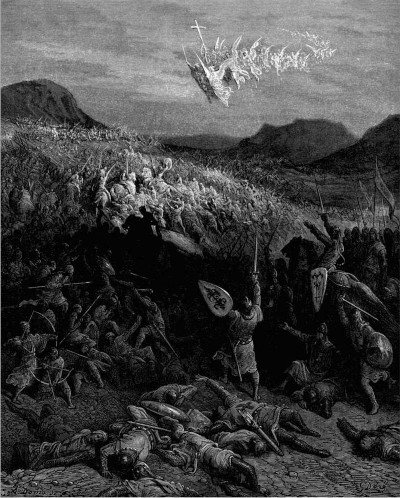The Battle of Dorylaeum occurred on the 1st of July, 1097. It was known as part of the First Crusade and took place between crusader forces and the Seljuk Turks.
The former were ultimately victorious, but only after some additional troops had arrived towards the end of the battle. There are many different accounts of this battle, with widely different claims over the number of troops involved in this conflict, but we do know that this was an historically significant event. Consequently, a scene from this battle was then taken on by Gustave Doré many centuries later for a series of illustrations. He would also take content from The Battle of Nicaea in 1097 which occurred in the preceding months of that summer. Ultimately the Nicaea battle would then lead onto Dorylaeum in an attempt to produce a definitive winner and these significant conflicts were both worthy of inclusion within Doré's History of the Crusades series from 1875. That set of artworks was based around the account delivered in Michaud's Histoire des Croisades, and so this series was related to historical war and literature.
The artist created 100 designs in total for this commission and the publishing was handled by Hachette and Co. in Paris, who the artist also collaborated with on other projects, such as London, Les Fables de Lafontaine, Orlando Furioso and also Dante's The Divine Comedy. He tended to then use British publishers for any publications in the UK and over time would develop strong relationships with a number of these major publishing houses. Although he loved to try out different mediums within his career, it would always be his book illustrations that provided a reliable income from which other projects could be financed. Indeed, he once said that he actually only produced illustrations in order to allow him to paint, but to produce work of such quality, there must have been considerable enjoyment and passion in it for the artist.
Within The Battle of Nicaea in 1097 we find intervention from high above, with the cross held aloft in victory. Down below in the horror of battle, we find bodies strewn all across the floor. Many lie in dark shadows, representing the reality of battle and the contrast between victory and the casualties that come with it. The appearance above of divinity shines a light down below across the hill side, with this open landscape filled with bodies from a bloody battle. The mountains jut up in the background and the lighting is dim, suggesting a long and intensive event. Sadly, this scene from Nicaea would then carry on again as the conflict from the First Crusade would continue for some time yet. The artist would carefully select elements from Michaud's text and then base artworks around that, using his imagination in order to best serve this classic piece of literature.




